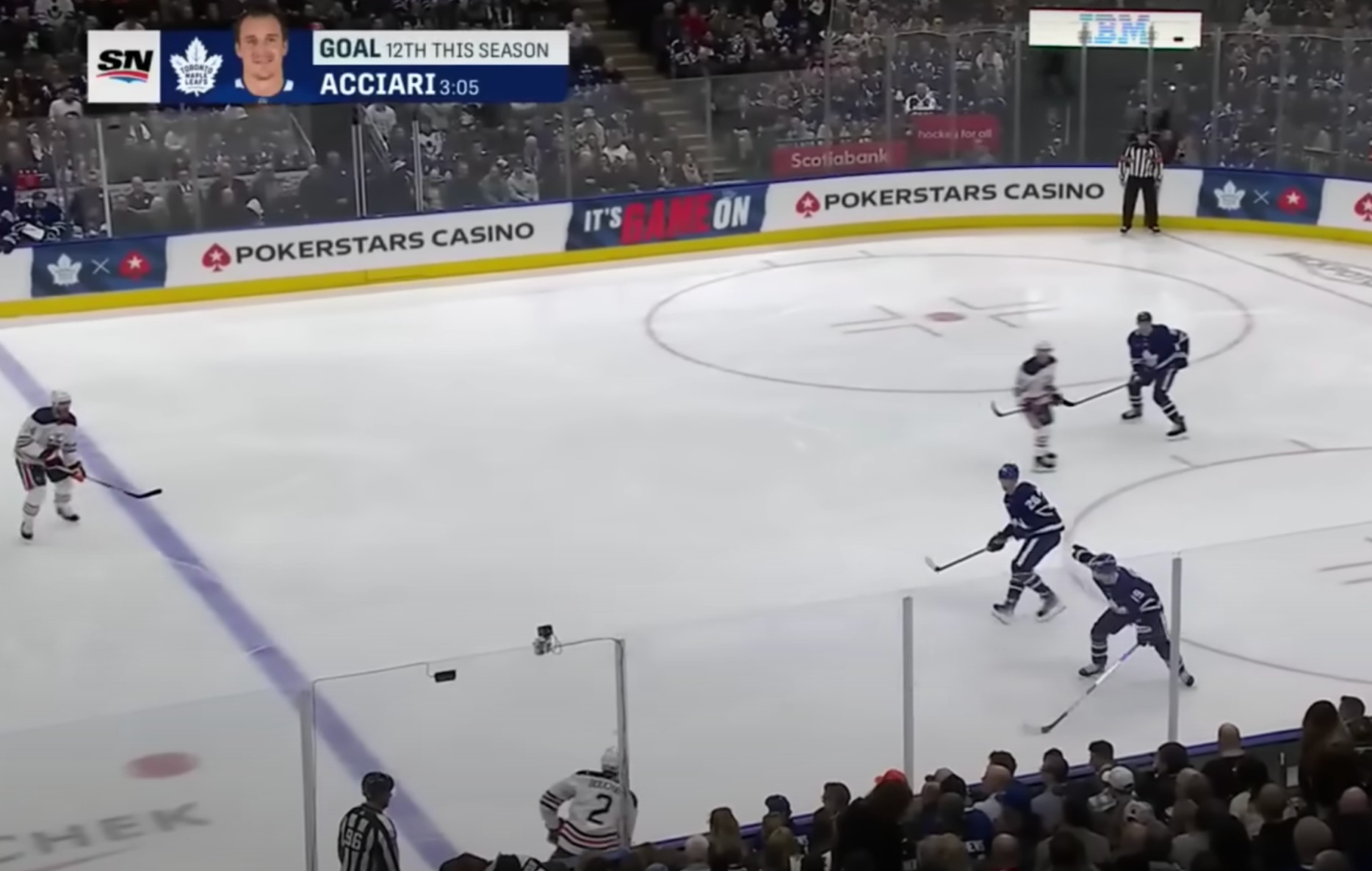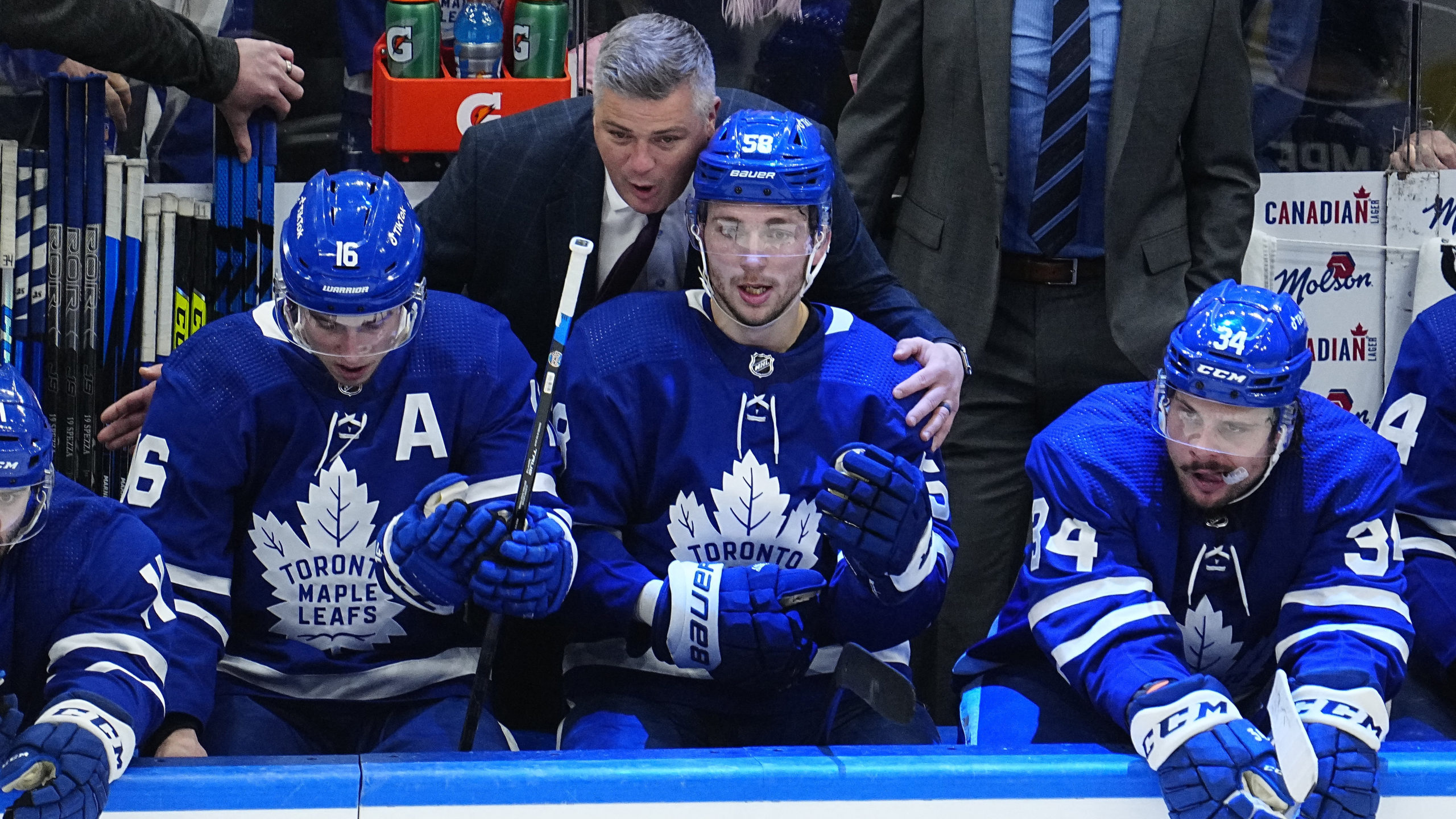When the dust settled after the trade deadline and we added up the Maple Leafs’ moves, it left them with a roster featuring 12 forwards, nine defensemen, and two goalies with presumably enough cap space to sign Matthew Knies and give him some sort of audition down the stretch.
Truthfully, it looked a bit awkward. The Leafs were flush with NHL defensemen, but when they traded away Rasmus Sandin and acquired a first-round pick in the process, most people – myself included – assumed Kyle Dubas would then try to flip the pick (or perhaps be more comfortable flipping other picks) in order to acquire a forward as the Leafs really lack NHL experience beyond their top 12.
If one forward falls injured, their current options are Pontus Holmberg, Bobby McMann, Alex Steeves, and eventually, Knies. Those four players have a combined 51 games of experience and 14 points to their names collectively. Holmberg has accounted for 13 of them.
To effectively double – or arguably triple – down on defense while not adding any sort of legitimate NHL support at forward is obviously noteworthy. It’s worth wondering what exactly the plan is here.
Well, before Ryan O’Reilly was hurt, the Leafs had their full complement of players and decided to dress 11/7 in games against the Calgary Flames and Vancouver Canucks. The first time Keefe ran it – against Calgary – he was asked about it:
“It is a unique circumstance here, obviously. We have two guys who are coming in new and fresh. It is a back-to-back. There were a lot of miles on our defense last night. For the most part, it was kind of an off night for our forwards. We weren’t on offense very much.
“The defense can share the minutes, and from here on forward, we should have lots of legs. It gives me an opportunity to try some different things and get our best people out on the ice more frequently.”
At the time, I didn’t think too much of it, largely chalking it up to the team adding multiple defensemen and wanting to acclimate them to the team. They ran it that night and played very well. They ran it again the next game against the Canucks and struggled, to put it nicely.
In the following game against the New Jersey Devils, the Leafs recalled forward reinforcements in Holmberg and Steeves, but both did very little – Holmberg even took a bad penalty – and both were out of the lineup by the time the Leafs played the Oilers again as they returned to 11/7.
The Leafs played a good response game and beat the Oilers, and a few days after Keefe had time to sit on it, he remarked:
“We’ve played some of our best hockey here with 11 and 7. You know I go back and look at our road trip, we played 12 and 6 in Edmonton which was probably the worst we played on our trip… And then we played 11 and 7 versus Calgary and that was the best we played… We might discover through this that we might be better with 11 and seven… Lightning went 11 and seven through two Stanley Cup runs.”
I’m still not sold that this is something the Leafs will regularly run with at playoff time. After all, the Tampa Bay Lightning teams Keefe mentioned went with 11/7 in eight out of 25 playoff games the first year they won the Cup and a measly three games the second year. Let’s not blow it out of proportion; they by and large won playoff games running a conventional 12/6 lineup.
On the flip side, where there’s smoke, there is fire. Not only do Keefe’s comments indicate he is liking it, but they have deployed this lineup configuration in four of their last five games, and in two of those games, all 12 of their forwards were available. It now warrants some more in-depth discussion.
The pros of 11/7
First off, what are the benefits?
The obvious one: The team can easily play its top players more as it’s easier to slide them on for extra shifts with third and fourth-line players. The coach doesn’t have to bench anyone to do it.
Marner taking a shift with, say, Sam Lafferty and Calle Jarnkrok against a third defense pairing is a matchup that the Leafs can exploit. Since Keefe took over behind the bench, he has never passed up an opportunity to play his top players as much as possible. If anything, he has gone out of his way to do so.
Even if we include the game against New Jersey where the Leafs dressed 12/6, over the past five games overall, all of Mitch Marner, Auston Matthews, William Nylander, and John Tavares are averaging at least a minute more ice time per game than their season averages.
| Player | TOI Season Average | TOI Last 5 Games |
|---|---|---|
| Mitch Marner | 21:12 | 23:25 |
| Auston Matthews | 20:02 | 21:29 |
| William Nylander | 18:32 | 20:19 |
| John Tavares | 17:33 | 18:44 |
For reference, Connor McDavid leads all forwards in time on ice per game for the season at 22:43.
Even beyond the top forwards, the coach is also able to get his depth players extra minutes and move players around, which suits a group like the Leafs. They aren’t deep beyond their top 12 forwards, but their top 12 group is deep. Beyond Zach Aston-Reese, Keefe can really justify moving anyone up and down the lineup quite easily. This makes it easy to find those players – such as a Noel Acciari or Calle Jarnkrok – some extra ice time.
The team is also able to dress “specialized” defensemen, which is important to the Leafs right now with their logjam of options. As we just saw with Rasmus Sandin, it is tough to stash a power play and offensive option down the lineup. The minutes are limited, and shielding a defenseman at five-on-five to pick up the tail end of power plays and play more in the event of the team trailing is not optimal.
With seven defensemen, it really doesn’t matter. In the game against the Calgary Flames where it was tight checking and the Leafs went up early in the third period, Erik Gustafsson played just 9:52. In subsequent games where the Leafs were down and chasing offense in all of them – against the Canucks, Oilers, and Sabres – he played 14+ in each.
The same would apply to the defensive side of the game; the team can stash an extra penalty killer/defensive defenseman (such as Luke Schenn) to play more if it is protecting a lead or has taken multiple penalties.
This is compounded by the fact that the Leafs don’t really have a do-it-all, top-of-the-lineup defender. Morgan Rielly is great offensively but not defensively, TJ Brodie is great defensively but not offensively, and so on and so forth. They can keep a specialized defensive and offensive option and simply play one or the other depending on the game situation. If they dress six, they have to make the decision before the game and run with it once the puck drops.
The cons of 11/7
On the flip side, there are drawbacks. The biggest one: The lines and defense pairs are in constant flux.
For hockey players who are creatures of habit, there is no consistency in this situation. Lines are constantly juggled, players are moved around, and the team ends up with shifts where linemates look like strangers.
Early in the game against Edmonton, Keefe put out a Jarnkrok – Lafferty – Nylander line which was instantly crossed up, with Jarnkrok pointing at Lafferty to cover the defenseman as if he’s a winger, allowing Ekholm all day to walk into a slapshot for a goal.
 Lafferty is obviously new and still adjusting even if there were 12 forwards dressed, but it’s hard to get into a flow when his linemates are changing not just game-to-game but shift-to-shift.
Lafferty is obviously new and still adjusting even if there were 12 forwards dressed, but it’s hard to get into a flow when his linemates are changing not just game-to-game but shift-to-shift.
The lack of flow is probably the biggest issue. Against Buffalo, there was a good example where the Leafs were up 2-0 and should’ve been stringing together good shifts in what was a fairly lifeless game halfway through. This is a situation where you would hope to roll your lines at home and string together good shifts, but the game just kind of… got away from them.
The Leafs can’t roll lines – they are constantly changing – so the game management changes behind the bench. The coach focuses on sending out forward combinations that make sense versus taking a pulse on the game and making line matching and deployment adjustments.
For the coach, it’s a lot to process just figuring out who is on next at all times, never mind taking stock of who is doing what at times or losing a player in your rotation. That lack of flow is why forwards don’t like it. Consistency in linemates is an easier environment in which to play, and when the top lines stay together, it makes it harder for the depth players to get into a groove, which just makes life more difficult for the weaker players in the lineup.
On defense is probably where 11/7 is most poorly received. Defensemen can’t stand it as they play less than normal in a position that usually requires a lot of ice time to settle in and play well (again: see Sandin and Timothy Liljegren when they played a lot due to injury vs. when the team got healthy).
With seven defensemen, this is how the Leafs created a situation over the past five games where Jake McCabe is averaging 18:03, Mark Giordano at 15:43, and even Morgan Rielly played just 19:14. Numbers like this will consistently produce these kinds of results when the team is dressing seven defensemen that the coach wants to play.
One caveat to note: The outlook would look a bit different with Ryan O’Reilly healthy. That would effectively give the Leafs five quality forwards to move around and exploit matchups with. Right now, with four high-end forwards, it feels a tad short, and they just end up loading up the top line’s ice time.
The results have been mixed. While the defensemen still probably wouldn’t like it, the strength of this team is unquestionably at forward, so there is an argument for catering to them.
Where it gets particularly dicey is in the playoffs, where Tampa Bay and Boston – the likely first two opponents – will run four lines. They will strategically try to drive the Leafs into the ground if they play a forward short every other night for two-plus weeks.
It’s one thing to run 11/7 when playing two games in a week against different opponents in March. The playoffs are a whole different animal, though.
Anthony Petrielli’s weekly notes, quotes, tweets of the week, and “Five Things I Think I’d Do” will follow tomorrow morning






























![New Leaf Anthony Stolarz on the opportunity in Toronto: “In Florida, I knew my role as a backup… Now, [Joseph Woll] and I are competing for starts… As a goalie, that’s all you can ask for” Anthony Stolarz, Stanley Cup win, now Maple Leaf](https://mapleleafshotstove.com/wp-content/uploads/2024/07/anthony-stolarz-sc-100x70.jpg)
